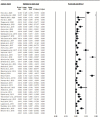Strongyloides Stercoralis Infection in Ethiopia: Systematic Review and Meta-analysis on Prevalence and Diagnostic Methods
- PMID: 33664615
- PMCID: PMC7912231
- DOI: 10.2478/helm-2021-0010
Strongyloides Stercoralis Infection in Ethiopia: Systematic Review and Meta-analysis on Prevalence and Diagnostic Methods
Abstract
Strongyloides stercoralis is a helminthic intestinal parasite that causes the disease strongyloidiasis. Its prevalence is high in tropics and sub-tropics due to poor sanitation and hygiene. However, its true prevalence is not well known in Ethiopia as most health institutions use low sensitive diagnostic methods. This review aimed to determine the pooled prevalence of S. stercoralis at country, and regional state levels. Papers published on S. stercoralis in Ethiopia from 2010 to 2020 were collected from PubMed, Google Scholar and Science direct databases and Addis Ababa repository. Identification, screening, checking the eligibility, and inclusion of the relevant literatures were done. Articles with S. stercoralis positive results from Ethiopian populations were included. Articles which focused on Strongyloides infection in foreigners, and other than stool samples were excluded. The pooled prevalence of S. stercoralis and heterogeneity between studies and across regions were computed. From the 43 articles, the overall prevalence of S. stercoralis in Ethiopia was 1.82 %. Across regions, relatively high prevalence of S. stercoralis (8.78 %) was recorded in Addis Ababa city. High prevalence of S. stercoralis was found to be 44.02 % with a combination of formol ether concentration, Baermann concentration, and molecular methods. Low prevalence of 0.26 %, 0.31 %, and 1.20 % was evidenced respectively with Kato-Katz, direct saline microscopy, and formol ether concentration methods. Using random effect analysis, the pooled prevalence of S. stercoralis in Ethiopia, across regions and across diagnostic methods was 2.1 % (95 %CI: 1.20 - 3.60), 2.6 % (95 %CI: 0.80 - 8.20) and 3.7 % (95 %CI: 1.10 - 11.70), respectively. The heterogeneity was high (P<0.001). This review revealed that Strongyloides infection is probably underreported and its prevalence could be higher than the reported in Ethiopia. Therefore, a revision of the best combination of diagnostic methods could be advisable as it gives better diagnostic results in routine diagnosis of Strongyloides infection in Ethiopia.
Keywords: Ethiopia; Strongyloides infection; diagnostic methods; prevalence.
© 2021 T. Hailu, E. Nibret, A. Amor, A. Munshea, published by Sciendo.
Conflict of interest statement
Conflicts of Interest The authors declare that we have no conflict interests.
Figures





Similar articles
-
Evaluation of five diagnostic methods for Strongyloides stercoralis infection in Amhara National Regional State, northwest Ethiopia.BMC Infect Dis. 2022 Mar 28;22(1):297. doi: 10.1186/s12879-022-07299-1. BMC Infect Dis. 2022. PMID: 35346087 Free PMC article.
-
Prevalence of Strongyloides stercoralis infection and associated clinical symptoms among schoolchildren living in different altitudes of Amhara National Regional State, northwest Ethiopia.PLoS Negl Trop Dis. 2022 Apr 28;16(4):e0010299. doi: 10.1371/journal.pntd.0010299. eCollection 2022 Apr. PLoS Negl Trop Dis. 2022. PMID: 35482629 Free PMC article.
-
Strongyloidiasis in Africa: Systematic Review and Meta-Analysis on Prevalence, Diagnostic Methods, and Study Settings.Biomed Res Int. 2020 Nov 15;2020:2868564. doi: 10.1155/2020/2868564. eCollection 2020. Biomed Res Int. 2020. PMID: 33274200 Free PMC article.
-
Epidemiology of intestinal helminthiases in a rural community of Ethiopia: Is it time to expand control programs to include Strongyloides stercoralis and the entire community?PLoS Negl Trop Dis. 2020 Jun 4;14(6):e0008315. doi: 10.1371/journal.pntd.0008315. eCollection 2020 Jun. PLoS Negl Trop Dis. 2020. PMID: 32497042 Free PMC article.
-
Global prevalence and epidemiology of Strongyloides stercoralis in dogs: a systematic review and meta-analysis.Parasit Vectors. 2022 Jan 10;15(1):21. doi: 10.1186/s13071-021-05135-0. Parasit Vectors. 2022. PMID: 35012614 Free PMC article.
Cited by
-
Trends in the prevalence and intensity of soil-transmitted helminth (STH) infection in Ethiopia 2000 to 2023: a systematic review.Parasit Vectors. 2025 Aug 9;18(1):340. doi: 10.1186/s13071-025-06928-3. Parasit Vectors. 2025. PMID: 40783768 Free PMC article. Review.
-
Modifications to the parasitological technique of Rugai increase the diagnostic sensitivity for strongyloidiasis.Parasitol Res. 2024 Jan 18;123(1):101. doi: 10.1007/s00436-023-08111-y. Parasitol Res. 2024. PMID: 38233532
-
Evaluation of five diagnostic methods for Strongyloides stercoralis infection in Amhara National Regional State, northwest Ethiopia.BMC Infect Dis. 2022 Mar 28;22(1):297. doi: 10.1186/s12879-022-07299-1. BMC Infect Dis. 2022. PMID: 35346087 Free PMC article.
-
Burden of neglected tropical diseases and access to medicine and diagnostics in Ethiopia: a scoping review.Syst Rev. 2023 Aug 14;12(1):140. doi: 10.1186/s13643-023-02302-5. Syst Rev. 2023. PMID: 37580784 Free PMC article.
References
-
- Abate A., Kibret B., Bekalu E., Abera S., Tekilu T., Yalew A., Endris M., Worku L., Tekeste Z.. Cross-sectional study on the prevalence of intestinal parasites and associated risk factors in Teda Health Centre, northwest Ethiopia. ISRN Parasitol. 2013;2013:2013. doi: 10.5402/2013/757451. - DOI - PMC - PubMed
LinkOut - more resources
Full Text Sources
Other Literature Sources
